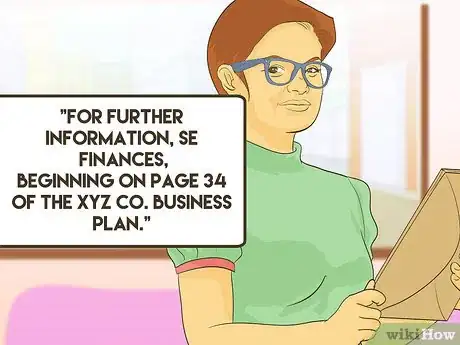This article was co-authored by Helena Ronis and by wikiHow staff writer, Jennifer Mueller, JD. Helena Ronis is Co-founder and CEO of AllFactors, a unified web analytics software to drive company's marketing and business growth. She has worked in product and marketing in the tech industry for over 8 years, and studied Digital Marketing & Analytics at the MIT Sloan School of Management Executive Program.
wikiHow marks an article as reader-approved once it receives enough positive feedback. In this case, 88% of readers who voted found the article helpful, earning it our reader-approved status.
This article has been viewed 67,507 times.
While banks are often hesitant to loan significant amounts of money to new companies, a venture capital firm typically is more willing to make a bet based on the future of your business and its long-term potential. With a venture capital deal, business owners sell equity in their business to the venture capital firm in exchange for operating cash. Venture capitalists make money by investing in companies they believe will be profitable in the future, providing a good return on their investment.[1] The venture capital process can be lengthy and expensive, and an impressive venture capital proposal is crucial to your success. A strong venture capital proposal shows you've done your research and planning, and have business acumen, focus, and writing ability, as well as an in-depth understanding of your industry.[2]
Steps
Drafting a Formal Business Plan
-
1Start with an executive summary. Succinctly tell the reader who you are and what you are asking for. This is the first section of your proposal and should immediately grab the attention of the reader.
- Keep in mind that investors at venture capital firms get a large number of proposals, and they often don't read past the executive summary. If your executive summary is not compelling and carefully written, your proposal won't go any further.
- Your executive summary should be brief – no more than two to four pages. It's okay if the reader won't have a good understanding of your business after reading the summary. You can delve into further details later on, but the summary should make them want to know more.
- Think of your executive summary as a pitch. Include things you would say if you met an investor in an elevator and had only a brief moment to tell them about your business.
- Focus your executive summary on the need your product or service would fulfill to help investors want to know more. For example, you might have created a mobile app that would allow people to securely transfer massive files rapidly without data loss. It doesn't matter that the investors don't understand the technical specifics of your code or how your algorithm works. If they had ever experienced the frustration of sending or receiving a large file, they would intuitively understand the use of your product.
-
2Describe your business. The next section of your business plan should include information about the general nature of your business, its history, and the business development history of any owners or major players in your business.
- Be sure to include contact information for the business as well as each of the owners. If there are key players in your company that have specific knowledge about certain aspects of your business, you should include information for them as well and explain their role.
- For example, if you're a tech start-up, you may want to include names and contact information for your head engineer or programmer. This can be especially valuable if they have previously worked on successful start-ups, or if their names are well known in the industry.
- This is the time to brag about any milestones you've reached, goals you've exceeded, or previous successes you (or anyone else on your team) has had.
- Provide some background of the people involved in your business, why they were chosen for their roles in the company, and the particular background or expertise they bring with them.
Advertisement -
3Analyze your industry. In the next section of your business plan, you need to show the investors that there is a real demand for the product or service you're providing. Use independent research to back up your statements about market size and trends.
- Keep in mind that generally it's better to identify a need that your product or service will fulfill than to appeal to the basic desire of some segment of the population. Ideally, you'll identify a niche market that is untapped, or has not been reached at the scale you plan.
- If you uncover negative trends that might not bode well for your business, you still should discuss them. Serious investors will conduct their own analysis. If they uncover something not mentioned in your business plan, it reflects poorly on the plan as a whole and can put your projections in jeopardy.
- For example, if you've developed a service in the ride-share sector, you might encounter resistance. The market seems saturated, and the infrastructure in many urban areas is struggling to adapt. You won't overcome that resistance by arguing that those negative trends don't apply to you. What would work is finding a way in which your particular service circumvents those problems, such as by focusing on rural areas, or providing accessible rides for people with disabilities.
- If you have the resources, you may want to hire an independent research firm to compile your data and analysis for this section. It will lend more credibility to your overall business plan in the eyes of investors, and it also shows that you have enough confidence in your company that you're willing to invest in its success.
- Prepare the data you used in your analysis so that you can provide it to any venture capital firm that requests it.
-
4Provide details about your target customers. When it comes to your target market, the more specific you can be, the better your chances of appealing to a venture capital firm. Identifying your key consumer shows that you understand your product or service and who will most likely be interested in it.
- At bottom, this section of your business plan tells investors who you will sell your product or service to. Try to identify that person with as many demographic and lifestyle details as possible.
- Start broad and get more specific. You typically will have a general class of consumers you're targeting. For example, you may intend to sell primarily to young urban professionals without children. Your core market is a smaller, more specific person, such as a single female with an advanced degree in her mid- to late-20s.
- Ideally what you want here is almost a biography of your target customer. Explain her reasons for buying your product or service, what needs it fulfills, and what other sorts of products or services she buys or uses on a regular basis. Include where she lives, how much money she makes, and how she makes decisions about products or services to buy or use.
EXPERT TIPHelena Ronis is Co-founder and CEO of AllFactors, a unified web analytics software to drive company's marketing and business growth. She has worked in product and marketing in the tech industry for over 8 years, and studied Digital Marketing & Analytics at the MIT Sloan School of Management Executive Program.Business Advisor
 Helena Ronis
Helena Ronis
Business AdvisorStruggling to figure out who your customers are? Helena Ronis, CEO and Founder of VoxSnap, tells us: "It's all about testing and validating. That's the only way to really know if the market wants what the entrepreneur is planning to build with their idea. It's in the process of testing that the entrepreneur really identifies who the customers are."
-
5Show your advantage against competitors. In this section of your business plan, you should accurately identify the competitors for your product or service. Competitors may be direct or indirect, and include anyone who fulfills the same need as your product or service.
- Focus on the need you're trying to fulfill, not the way in which you're fulfilling that need through your product or service.
- For example, if you plan to start a ride-sharing service, you're fulfilling the need that people have to go places. Your competitors include not only other existing ride-share companies, such as Uber and Lyft, but public transportation, taxi cabs, and private shuttle services offered by hotels or employers.
- Once you've identified your major and minor competitors, distinguish your business from your rivals by explaining why customers would choose your product or service over those offered by the entities you've mentioned.
- To return to the ride-sharing example, you might point out that existing ride-sharing services and other transportation options don't adequately address safety concerns of female passengers. Your service is designed to address these concerns by allowing riders to choose their drivers and providing detailed background information about each driver available.
-
6Discuss your marketing plan. Your marketing plan should explain to the investor your strategies and methods for penetrating the market, and how you plan to turn one-time customers into repeat customers.
- If you have a marketing or advertising team within your company, or have contracted with an outside advertising firm, this is the place to identify those people.
- Describe the specific promotions you'll employ and why you believe they'll be successful at achieving your goals. You also should explain how your product or service will be delivered to your customers and any relationships you have with other businesses.
- For example, your ride-share service might be delivered through a mobile app your customers would download for free. You might offer promotions such as discounts on a customer's first ride, with additional discounts after each customer's five ride, tenth ride, and so on to keep them coming back to you. Providing riders with referral bonuses gives them an incentive to help you grow your business. You also might have partnerships with local bars, in which riders get a discount for using your service to get a ride home.
-
7Present your plan for operating your business. In this section of your business plan, you need to paint for the investor a realistic picture of how you will run your business on a daily basis, including plans to scale your business as it grows.
- When you're writing your business plan, your business may only exist on paper – or it may already be a small going concern. If you haven't started operations yet, this section of your plan may feel more speculative. However, it's important to be as specific as possible so you send the message to the investors that your business is grounded in reality.
- If you're unsure about the details about managing the daily aspects of your business, talk to someone who has experience running a start-up to get some ideas of the kinds of challenges you're likely to encounter.
- In this section, investors are looking for someone who has a realistic idea of what running a business is like, and who knows how to navigate a growing business over various hurdles.
- Along with your operational plan, you'll want to include a timeline of various milestones you aim to reach and exceed within your first five to ten years of operation. These milestones should be consistent with all other aspects of your business plan, including your finances and your market analysis. They also should be credible goals that your business is objectively capable of meeting. This is not the time for pie-in-the-sky optimism.
-
8Outline the business's finances. Since a venture capital firm is purchasing a part of your business, they want to ensure that it will be profitable in the long-term, even if it isn't right now. This section should include detailed outlines of development, start-up, and operating expenses, as well as projections of future income.
- Provide a list of all actual and potential revenue streams for your business, including sales of your products and services, licensing, or other potential sources.
- Make sure that your assumptions and projections are well grounded in the analysis presented in other sections.
- Establish clear and realistic goals for your company, based on the market research and analysis you've conducted. For example, you might set a goal to increase your market share by 5 percent within six months from the launch of your product or service.
- You may want to look at business plans created for businesses similar to yours to get a good idea of realistic projections. Ideally, you can find business plans for companies in your industry that have been in operation for several years so you can compare the projections in their plan to what actually happened.
Making an Investment Proposal
-
1Provide a short history of your business. If you're already operating, you should include a brief history of the development of your company over time. However, even if your business only exists on paper at this point, you still need to explain the development of your concept and the people involved.[3]
- Include details about your business's legal structure. If you're incorporated, let potential investors know the state, country, or territory in which you're incorporated, as well as locations in which you're legally registered or licensed to do business.
- If there are any particular licenses or permits you must have to do business, list those and the dates they have been or will be acquired.
- Provide the names and contact information of each of the owners, including the amount of equity they own in the business. If there have been any changes in ownership since the inception of your business, you should briefly describe those.
- You also want to provide a brief explanation of the product or service you intend to provide, and what need you believe it will fulfill for your target consumers.
-
2Describe the level of investment you need. This section of your investment proposal lists the amount of cash your business needs and how much of an equity stake you're prepared to offer in exchange for this amount.[4]
- These numbers should be specific to each venture capital firm, if you send proposals to more than one. Research the firms carefully and look at the terms of their past deals to get a better idea of what they might accept.
- Consider these figures carefully, since setting them too high or too low can not only turn off a potential investor, but may put your company in a bad position if you have to go through additional rounds of financing. It's best to talk this over with an accountant, attorney, or other certified investment professional who has experience in venture capital financing. Keep in mind you may want more than one opinion.
- Try to be as objective as possible about your business and its chances for success if fully funded. Overconfidence can result in alienating investors with a figure that's too high for limited equity, while not being aggressive enough can mean you don't end up with as good of a deal as you could have.
- At the same time, keep in mind that investors typically will want to negotiate. If your proposal is your bottom line and the only terms you're willing to accept, you lose a lot of flexibility and can cost yourself a deal. Choose terms that give you room to maneuver in several areas.
-
3Explain how the money will be used. Venture capitalists are not interested in throwing money at you so you can do whatever you want with it. Even an investor who was inclined to invest in your company might balk at the way you intend to use their money.[5]
- Break down the expenses for which you intend to use the money to show that you're asking for a realistic amount that is feasible to cover the listed expenses and keep you operational.
- If you intend to go through multiple rounds of venture capital financing, you should identify when you plan to start searching for second-round investors, and how later investments will effect the equity of earlier investors.
-
4Incorporate your formal business plan. Your investment proposal typically will be a shorter document that summarizes many of the key points in your business plan. However, your full business plan will provide investors with the detail they need to properly evaluate your business.[6]
- You can include pinpoint references throughout your investment proposal that direct potential investors to the relevant portions of your business plan. That way they can find the information they need without having to read through the whole report in one sitting.
- For example, when you're explaining how you intend to use the money, you may include a note at the end of that section that says "For further information, see Finances, beginning on page 34 of the XYZ Co. Business Plan."
-
5Provide names and contact information for references. Any legal or financial professionals who have contributed to your business in any way, or who are currently advising you, should be identified so potential investors can contact them with questions.[7]
- Your references also should include your banker, accountant, and any other business credit references.
- If you had an adviser who helped you initially, but is no longer associated with your company, you may want to include them as a reference and explain why you no longer use their services.
- Make sure you contact anyone you list in advance and let them know you are using them as a reference on your investment proposal to venture capitalist firms. If they have a preferred method of contact (for example, they prefer phone over email), be sure to include that information.
-
6Include a potential exit strategy. Most investors want to stay with your company for the long haul, but they also realize that nothing is guaranteed. Show them that you respect their time and money by being realistic about the risks of investing in your company.[8]
- This portion of your investment proposal also shows potential investors that you are thinking about the long-term and committed to building a company of great value.
- Look at the stories of venture capital firms who invested in companies similar to yours and exited successfully to get ideas of how to structure this section of your proposal.
- When crafting an exit strategy, try to plan it so exit is feasible within three to five years.
- For example, you may include a goal of the company going public within three years of the launch of your product or service. Provided the price per share at your initial public offering (IPO) is set well above the price at which the venture capital firm purchased equity in your company, this is a strong potential exit strategy.
Negotiating a Deal
-
1Submit your investment proposal. Some firms have an online process you can use to submit your proposal, while others may require you to send it in the mail. Contact each firm to which you will submit your proposal in order to determine their submission procedures.[9]
- Check the firm's information carefully and make sure you've included everything in your proposal that they've requested, and that your documents are all organized in the proper format.
- If the firm requires a specific cover sheet or cover letter, make sure you've created one that conforms to their specifications.
- Keep in mind that if your proposal does not meet a firm's technical specifications, it may be rejected without consideration. Venture capital firms receive hundreds of investment proposals, and it is important to them that all of these documents are organized in the same way so investors can find the information they need easily.
-
2Wait for a response. Venture capital firms go through extensive due diligence, a process through which they determine whether your business is worth their investment. If the firm does not provide you an estimate of their timeline, give them at least a few weeks before you follow up.[10]
- During this period, an investor may contact you and request further information or documentation to back up or validate information in your business plan. Ask the investor's preferred method of delivery, and get that information to them as soon as possible.
- If several weeks or months elapse and you haven't heard from the firm, call and ask to speak to the investor working on your proposal. If you've had an offer from another firm, let them know to put some pressure on them to take action.
-
3Meet with venture capital firms. If a firm contacts you to set up a meeting, this typically means they're tentatively interested in making an investment in your company. They want to talk to you and any other partners to find out if you present in person as well as you do on paper.[11]
- Anticipate the investors' questions so you have answers prepared. Make sure you're intimately familiar with your business plan, as it will be the source of most of those answers.
- Be ready to haggle the terms of the investment. Rarely will a venture capital accept the terms you've proposed without some negotiation.
- While you should walk into the meeting with a bottom line, you also should prepare several alternatives that you're willing to accept if the firm isn't willing to fund you on the terms you originally proposed.
-
4Compare funding offers. If you've written a successful and compelling venture capital proposal, you may end up with more than one venture capital firm that is interested in investing with your company. If this happens, you need to thoroughly evaluate each offer so you can make a decision.[12]
- Consult your partners as well as any legal or financial advisors who have been instrumental in the development of your business plan.
- Keep in mind that anyone who has an equity stake in the company is potentially impacted by the decision, particularly the stock valuation on which the venture capital firm's investment is based.
- Who actually has a say in which offers you pursue further will depend on how your business is structured. For example, if you have a corporation with five board members and your articles of incorporation require unanimous votes regarding new investments, each of you would have an equal say in how you proceed.
-
5Be willing to leverage your alternatives. If there are several firms that are willing to fund your company, you may be able to play them against each other – even if none of them is ideal from your prospective.[13]
- A company often is perceived as more valuable if there are several different venture capital firms interested in making an investment. You can use this competing interest to encourage an investor you prefer to make an offer that better suits the needs of your company.
- Think about the interests of the venture capital firm as well. At your meeting, ask why they are interested in your company, and what their thoughts are on the prospects of your product or service. If you know their interests, you may be able to capitalize on them to negotiate a better deal.
- Keep in mind that after you accept an offer, any other offers that were made have no value. What value they may have lies in your ability to use them to get the best possible deal.
-
6Choose the firm that best meets your business's needs. After all consultation and negotiation is completed, you must make your ultimate decision. The offer that is best for your firm may not get you the most money, but it will best ensure the long-term financial health of your company.[14]
- For example, if you anticipate going through several rounds of financing, it may benefit you to take a lower amount of money in exchange for a smaller amount of equity, which will give you more to bargain with in the next round.
- Another aspect to keep in mind is the valuation of stock in your company. If the valuation is high, you may consider this a compliment to your company. However, a high valuation can hurt you in subsequent rounds if your company hasn't met its milestones, or your product or service hasn't performed at the level you thought it would.
- You also want to consider the investor who will be in charge of your account at the venture capital firm. Make sure they're someone you and other owners of your company work well with, especially if they're going to have a seat on your board.
References
- ↑ https://www.sba.gov/starting-business/finance-your-business/venture-capital/venture-capital
- ↑ http://www.slideshare.net/AndreaComastri/11-key-elements-of-a-high-quality-business-investment-proposal
- ↑ http://www.slideshare.net/AndreaComastri/11-key-elements-of-a-high-quality-business-investment-proposal
- ↑ http://www.slideshare.net/AndreaComastri/11-key-elements-of-a-high-quality-business-investment-proposal
- ↑ http://www.slideshare.net/AndreaComastri/11-key-elements-of-a-high-quality-business-investment-proposal
- ↑ http://www.slideshare.net/AndreaComastri/11-key-elements-of-a-high-quality-business-investment-proposal
- ↑ http://www.slideshare.net/AndreaComastri/11-key-elements-of-a-high-quality-business-investment-proposal
- ↑ http://www.slideshare.net/AndreaComastri/11-key-elements-of-a-high-quality-business-investment-proposal
- ↑ https://www.sba.gov/starting-business/finance-your-business/venture-capital/venture-capital
- ↑ https://www.sba.gov/starting-business/finance-your-business/venture-capital/venture-capital
- ↑ https://www.sba.gov/starting-business/finance-your-business/venture-capital/venture-capital
- ↑ https://hbr.org/2013/05/how-to-negotiate-with-vcs
- ↑ https://hbr.org/2013/05/how-to-negotiate-with-vcs
- ↑ https://hbr.org/2013/05/how-to-negotiate-with-vcs









































































